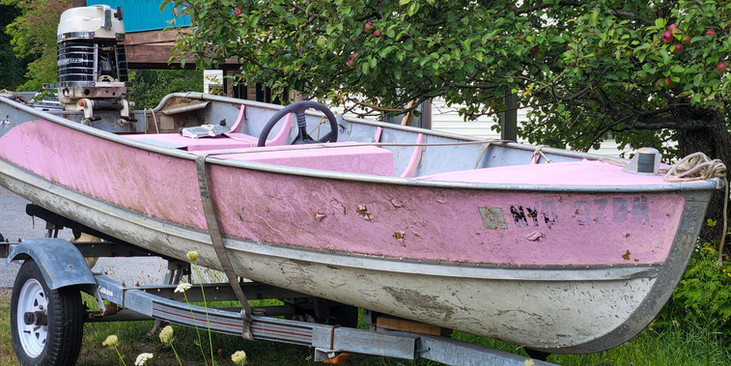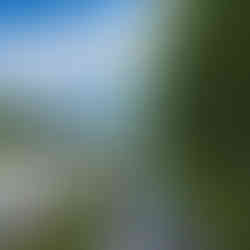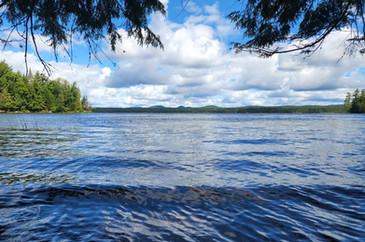Forked Lake loop
- Andrew Meunier
- Aug 29
- 4 min read
Ever since racing the Black Fly Challenge a pair of times a few years ago, I've been curious about the Moose River Plains area. The 20+ miles of dirt road cutting through dense forest seemed like it could be worthy of a more leisurely visit. So for a final summer bike trip, I created a route that traverses the Plains and passes by no fewer than five state campgrounds. My friend Dylan gamely agreed to join me.
Day 1: 56 miles with 4,213 feet of climbing
We parked at Limekiln State Campground where it was $8 to park overnight in their lot. Shannon the caretaker, perhaps skeptical of our plan, even threw in an extra night for free! Less than a quarter mile after leaving the campground, we entered the Moose River Plains to start our counterclockwise loop. Limekiln Lake-Cedar River Road is in good condition overall with a decent surface for biking. The biggest challenge was one I remembered from racing the Black Fly: regular small-to-medium-sized rocks jutting out of the otherwise smooth roadbed. These can be particularly diabolical on a sunny day when the dappled light camouflages them perfectly. Fortunately, we were rolling along at far from race-pace, so there was plenty of time to avoid them.

The Moose River Plains complex apparently has over 100 primitive campsites. The ones I saw exceeded my expectations. Most had picnic tables, concrete fire pits, and privies. The best were set back a bit from the main drag. Even though there are a huge number of sites, they were well dispersed along the road. We saw plenty of occupied sites but lots of empty ones too.
The biggest climb of the trip was done by mile 20 and we soaked in occasional sun rays as we enjoyed lunch (Dylan's sandwich with homemade mayo put my assorted bars to shame—I really have to up my lunch game!). After that, it was mostly downhill to the former ranger station at Wakely Dam. We overlapped with the Northville-Placid Trail for a few miles and I remembered hiking this section pursued by a small cloud of deer flies. More dirt roads finally yielded to asphalt and a ride through some sparsely populated countryside before turning onto Route 28. The Lake Durant State Campground made for a nice pitstop (the caretaker let us use the excellent facilities for free). We then pointed our bikes north through Blue Mountain Lake and up and over a few more climbs. I briefly ducked into the Adirondack Experience Museum where I secured some maple kettle corn and crackers from the gift shop. I'm embarrassed that I haven't visited this place yet. It looked like they had some high-quality exhibits. I'll have to come back for a longer stop.
The stretch of road between Blue Mountain Lake and Forked Lake State Campground is devoid of much settlement (in the words of the museum attendant: "There's nothing that way!"). Occasional swampy terrain with a backdrop of low hills and evergreen forests were all there was to see as we finished up our ride. Once I glimpsed a handful of maples whose leaves were starting to change. This and the cool air reminded me that summer was on its way out.
Forked Lake State Campground (pronounced "fork-ed") is unique in that all of its sites are accessible only by boat or trail. The walk to our site took about ten minutes and the sun was low in the sky as we settled our bikes, arranged our tents, and organized dinner. What our site lacked in flat tenting areas it made up for in pleasant lake views. Two large cedars leaned over a rocky beach. We watched several families canoe by even as the sun was setting. Both Dylan and I turned in early for what turned out to be a perfect night for sleeping: almost no moon and temperatures in the 40s.
Day 2: 40 miles with 2,782 feet of climbing
In the morning, we were on the road by 8:30 and retraced our path back to Blue Mountain Lake. We watched morning hikers mobilize at the Blue Mountain Trailhead in a light drizzle while we snacked at the forest's edge. We followed Route 28 west past Blue Mountain Lake, Utowana Lake, and Raquette Lake. After rolling through the tiny hamlet of Raquette Lake (most people we saw were doing boat-related things), we tackled the steepest climb of the trip and continued on to a long dirt stretch. We biked by the Brown Tract State Campground with its many pull-in sites along the road. These campers were a different breed than the Forked Lakers. Elaborate trailers, flags and family signs, bevies of chairs, piles of firewood; these folks were regulars and well-settled in.
Browns Tract Road (yes, not "Brown" or "Brown's") rolled on for several miles, passing numerous seasonal camps on the north side of the road. Most of these seemed a bit neglected—tarps, rotting plywood, and campers slowly being consumed by rust and moss. Others looked like they saw at least occasional visits and most had a camp name emblazoned somewhere on the property. The dirt road transitioned to fresh asphalt as we turned back onto Route 28 outside of Inlet. A convenient paved bike path hugged the road for a mile or so, a bit of a rarity in the Northcountry. Inlet was bustling with activity, but we decided to push on for the final few hilly miles back to the car.
This was a great overnight loop. I enjoyed the experience of the Adirondacks outside of the High Peaks region: fewer determined hikers, more paddlers and campers. I was surprised by the density of state campgrounds and how well-used they appeared to be. The road through Moose River Plains was neat to include in the route, if a bit dull. I could imagine staying at one of the sites along that road someday. When it came to riding, the mix of pavement and dirt kept things interesting. My rigid mountain bike was especially well-suited to some of the rocky descents, but Dylan's 50 mm road tires did well too (he appreciated his shock-absorbing seat post). Forked Lake was a fun place to stay, but I could imagine reprising this route and staying at one of the many other overnight options along the loop.




































































Comments